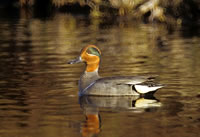
Wetland Functions
The functions wetlands provide of direct benefit to humans and nature and the value of those functions will, of course, vary according to the type of wetland system and the season of the year. Wetland functions and values include the following:
Water Quality Improvement: Wetlands have been referred to as the “kidneys of the landscape” because they often act as natural filters by decreasing contaminant concentrations in the water column (e.g., White and Burken, 1998; Nairn and Mercer, 2001). Contaminants are removed by a variety of processes, including physical settling resulting from long retention times with low-velocity flows, uptake by hydrophytic vegetation, microbial action and reactions with the atmosphere (e.g., Buchberger and Shaw, 1995; Tanner, 1996).
Flood Protection and Erosion Control: Wetlands can also function like a “sponge”, absorbing and retaining relatively large volumes of water, and then releasing it slowly over several weeks or months. By providing temporary storage of storm or snowmelt water, wetlands can decrease peak flows in receiving waters and lower the energy in streams, resulting in reduced flooding and minimized damage downstream (Kleiss, 1996). In doing so, wetlands help protect adjacent and downstream property and reduce damage to roads, bridges and crops. In riparian areas, trees and other hydrophytic vegetation help slow the speed of flood waters and can absorb and dissipate the force of wave action, reducing erosion along streambanks and shorelines (Kumar et al., 1996).
Groundwater Recharge and Discharge: Although not all wetlands recharge groundwater, some wetlands serve as a source in replenishing groundwater supplies, and vice versa (Gerla, 1999; Mitsch and Gosselink, 1993). For example, approximately 31 percent of water supplied to a constructed wetland in the Florida Everglades recharged the groundwater beneath it (Choi and Harvey, 2000). Water that would otherwise end up in downstream rivers and lakes or evaporate into the atmosphere can percolate through the soil into aquifers. Because water tables can fluctuate with seasonal variations, some wetlands may recharge groundwater during dry periods and receive groundwater during wetter months (Hunt et al., 1999).
Biological Habitat: Wetlands provide habitat for organisms ranging in size from large to microscopic, and contribute to the biological diversity and stability of the landscape as a whole (King and Brazner, 1999; Jurgensen et al., 1997). For example, migrating birds use wetlands as feeding, rearing and stopover sites (e.g., Naugle et al., 2000), while various invertebrates (e.g., Nordstrom and Ryan, 1996), amphibians (e.g., Lehtinen et al., 1999) and fishes (e.g., Faunce and Paperno, 1999) commonly utilize wetlands during all or part of their life cycle. The habitat needs of many wildlife species are found in wetlands, including shallow water for breeding and rearing of young and dense vegetation stands which provide food and shelter.
Education, Recreation, and Aesthetic Values: Wetlands may serve as living, outdoor laboratories where unique plant and animal species can be observed. The principals of ecological systems such as energy flow, recycling, and carrying capacity can be studied first hand. Wetlands are often aesthetically pleasing, capable of evoking in humans a sense of wonder, and stirring an appreciation of nature as one witnesses a flock of ducks taking flight from a playa, a heron stalking its prey in an oxbow lake, or hears the sounds emanating from a swamp on a summer night. Wetlands provide endless opportunities for popular recreational activities such as hiking, canoeing, boating, fishing, hunting, photography, bird watching and swimming.
Economic Values: The economic value of wetlands is substantial. A plethora of natural products of use to humans are to be found in various wetlands. Those with direct economic benefits include timber, fish and shellfish, wildlife, blueberries, cranberries and wild rice. In fact, nearly all commercially harvested fish and shellfish and most recreational fish depend on wetlands for food and habitat during some part of their life cycle (Feierabend and Zelanzy, 1987). While the benefits of wetlands from fisheries and waterfowl are substantial, they pale in comparison to the economic benefits from wetland ecosystem functions such as groundwater recharge, flood control and protection, water quality improvement and erosion control (Costanza et al., 1997).